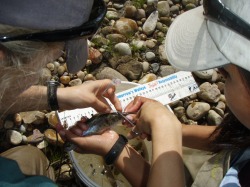Background Information
As a consequence
of rapidly expanding road networks in Alberta, there are increased
incidences where streams and roads must intersect. Road/stream crossing
structures can result in habitat loss and degradation through
alterations to the streambed, stream hydraulics, erosion and
sedimentation as well as altering ecological processes like hydrology
or organism movements (Haskins and Mayhood 1997, Jackson 2003).
Of the stream crossing structures (i.e bridges or culverts), culverts
have the most negative impacts on the surrounding stream habitat and
biota (Warren and Pardew 1998,). However, very little is known how
these stream crossing structures affect stream fish communities.
With the growing importance on maintaining biodiversity, there is a
need to adopt a more holistic approach that acknowledges the roles of
all species in contributing to aquatic ecosystem ‘health’ (Sylte 2002).
Why Is This Important?

Learning more about
how stream crossing structures contribute to the presence/absence of
different fish species will help us gain an understanding of how stream
fish communities are being affected when roads and streams intersect.
In addition, we will be able to address the future implications that
this may have on the longterm persistence of stream fish assemblages.
This information can then be used to direct management efforts.

